Madeline Wimmer- UMN Fruit Production Extension Educator
This fruit update contains information about…

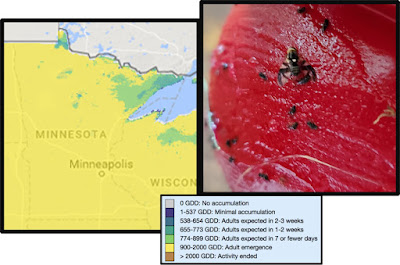 Images: A map of Minnesota (left image) on 07/31/24 showing full adult apple maggot emergence (yellow) in most parts of Minnesota and imminent emergence for some northern regions (light and dark green; image retrieved from the USA National Phenology Network). A red sticky ball trap (right image) showing an apple maggot, identified by its size, clear wings with zig-zag black banded patterns, and a white spot on their back (photo credited to Clover Valley Farm located near Duluth, MN, Zone 4b).
Images: A map of Minnesota (left image) on 07/31/24 showing full adult apple maggot emergence (yellow) in most parts of Minnesota and imminent emergence for some northern regions (light and dark green; image retrieved from the USA National Phenology Network). A red sticky ball trap (right image) showing an apple maggot, identified by its size, clear wings with zig-zag black banded patterns, and a white spot on their back (photo credited to Clover Valley Farm located near Duluth, MN, Zone 4b).
Apple maggot adults are fully active in most parts of Minnesota and are just beginning to emerge in the northeast regions. Apple maggot trapping and management was covered in previous Fruit Updates for July 3rd and June 12th this year. Growers looking for chemical management options for apple maggot can refer to the Midwest Fruit Pest Management Guide. One non-chemical management option for growers is kaolin clay, which acts like a physical barrier that can prevent some types of insect pests, including apple maggot, from feeding and egg laying. It also masks the green color, making plants difficult to locate for some insect pests. Applying kaolin clay should be done after the first apple maggot trapping, and growers should keep in mind that this strategy will likely be less effective than insecticide applications. Additionally, kaolin clay is most effectively applied with a tank agitator to prevent clumping and settlement. For most effective use, follow the application instructions located on the product label (e.g., Surround AlWP).
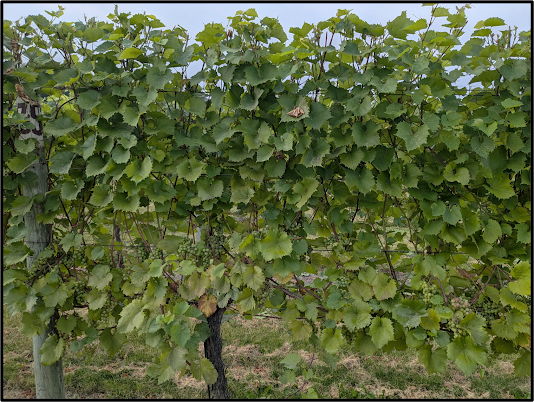 Image: Marquette grapes at the UMN Horticulture Research Center entering the very early stages of veraison, the point when grapes begin to soften, increase in sweetness, and decrease in acidity. Photo taken by John Thull, UMN Vineyard Manager.
Image: Marquette grapes at the UMN Horticulture Research Center entering the very early stages of veraison, the point when grapes begin to soften, increase in sweetness, and decrease in acidity. Photo taken by John Thull, UMN Vineyard Manager.
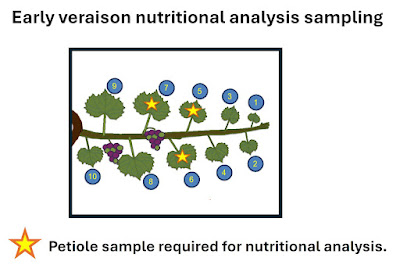 Infographic: Petioles sampled during veraison should be selected from the 5th, 6th, or 7th leaf when counting down from the grape shoot tip.
Infographic: Petioles sampled during veraison should be selected from the 5th, 6th, or 7th leaf when counting down from the grape shoot tip.
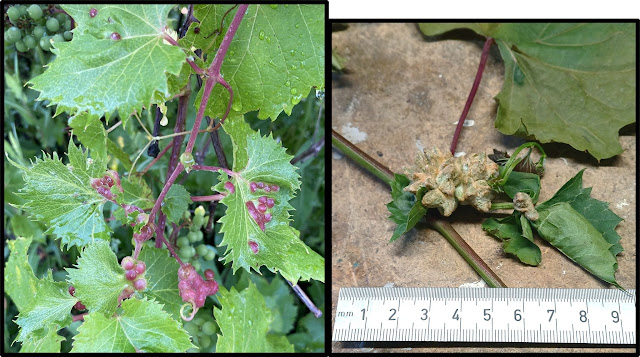
Images: Grape tumid gall maker (left photo; Vitisiella brevicauda) can create fuchsia-colored, bumpy galls that protect developing larvae. Filbert galls (right photo) are created by Ampelomyia vitiscoryloides. Both gall types very rarely cause economic damage to infected grapes, but should be removed when noticed. Photo (left) was submitted by a grower from Polk County, MN, and photo (right) was submitted by a grower from Winona County, MN.
A gall is a physical growth that leads to distortion of a specific plant part. The grape phylloxera is one of the major insect pests that creates galls on grape leaves, but there are other insects that occasionally produce galls too. While they are not usually a cause for concern or need for management, it is still helpful to know what they look like.
Grape tumid gall maker
The grape tumid gall maker is a midge fly that lays eggs within unfolding buds and developing shoots. After the eggs hatch, the gall begins to form as the larvae feed. There are a wide range of tissues that can form galls, including leaves, shoots, petioles, tendrils, and even flower clusters. The damage is usually very minor as cluster infection is not guaranteed or common. If you see galls in your vineyard, removing the infected tissues and destroying them is adequate and no insecticides are needed for its management. For vineyards that are uniquely challenged with high populations, it is still difficult to time insecticide applications because the adults only live for one day. One cultural strategy to manage the adults is to attempt to bury the pupae on the ground in the early spring with less-course types of mulch or dirt, which can be done near vines that had issues the previous year.
Grape filbert galls
Also known as hazelnut galls, the midge fly that produces the grape filbert gall is Ampelomyia vitiscoryloides. These galls look similarly bizarre—they can have a smooth or fuzzy texture—difficult to miss, and very rarely cause economic levels of damage on grapes.
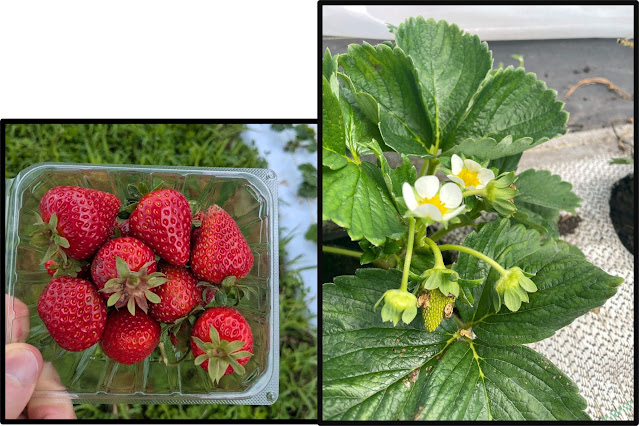 Images: A container of day-neutral strawberries (left photo); and a day-neutral strawberry plant flowering and setting fruit in a caterpillar tunnel (right photo), which is an example of a modified growing environment that can help produce quality fruits and lengthen the production season. Left photo taken by Matthew Gullickson, UMN Postdoctoral associate.
Images: A container of day-neutral strawberries (left photo); and a day-neutral strawberry plant flowering and setting fruit in a caterpillar tunnel (right photo), which is an example of a modified growing environment that can help produce quality fruits and lengthen the production season. Left photo taken by Matthew Gullickson, UMN Postdoctoral associate.
Day-neutral strawberries can produce berries throughout the growing season and tend to peak in production in August and September in Minnesota. The excess rain experienced earlier in the growing season presented challenges for strawberries and some growers have reported slower than normal plant establishment this year, although plants have been noticeably catching up the past few weeks.
Excess rain can be especially problematic for strawberries that are planted in the ground without mounded rows, which help by encouraging drainage. Using protective coverage like high tunnels or caterpillar tunnels can also mitigate some issues associated with excess rain. Day-neutral strawberries grown in table-top systems additionally had some advantage in mitigating these issues.
In June-bearing strawberry production, strawberry runners—the stolons that produce daughter plants—are utilized to create matted rows for production. In contrast, day-neutral strawberries are managed as individual plants within a single planting hole along a row and runners are removed regularly to encourage the plants to put their energy into fruiting. This can be time consuming, but an important step for production.
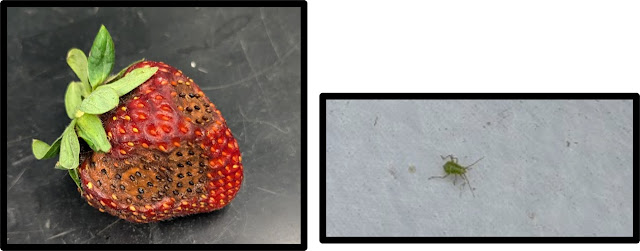
The University of Minnesota day-neutral strawberry plot, managed with organic production practices, has observed anthracnose fruit rot (Colletotrichum sp.) and a small amount of gray mold (Botrytis cinerea) during the 2024 production season. Researcher Matthew Gullickson of the UMN Rogers lab has reported 21.3% of day-neutral strawberries were infected with anthracnose fruit rot and thus deemed unmarketable for this year. Anthracnose fruit rot is identified as sunken, dark lesions on fruit, but can also show up as lesions on strawberry petioles. Growers who are experiencing anthracnose fruit rot within a day-neutral strawberry planting should keep in mind that inoculum can be spread by rain splash—which can be exacerbated by smooth plastic mulch surfaces—and transfer to other plants from equipment or by hands during harvest. For situations where only some areas of a field are heavily infected, harvesters should plan to start in “clean” field regions before moving into areas where infection is present.
Additional reading:
Anthracnose on Strawberry Fruit (PennState Extension)
Tarnished plant bug
The tarnished plant bug (Lygus lineolaris) is considered to be the most economically significant pest for Midwestern strawberry production. When the nymphs feed on flowers, it leads to deformed berries. This year, UMN researchers have noted 11.8% of unmarketable strawberries due to damage from tarnished plant bugs and populations are currently at the highest point of the season as of July 30th. This amount of damage may seem high, but damage can be much higher and controlling populations early on can be critical for preventing major outbreaks. Additionally, balancing tarnished plant bug management with pollinator protection can be challenging for day-neutral strawberries due to the continuous fruit production (see article below under additional reading). Good weed management within and on the perimeter of a strawberry field can be an additional cultural management strategy to prevent tarnished plant bugs from entering.
Additional reading:
“Managing tarnished plant bug on day-neutral strawberries” (University of Minnesota Extension)
Thank you to Andy Petran from the Twin Cities Berry Company and Aaron Hill from Little Hill Berry Farm for their contributions to this section, as well as Matthew Gullickson, UMN Postdoctoral associate for information related to day-neutral strawberry research updates.
This fruit update contains information about…
- Apples
- About: Moldy core
- Apple maggot status
- Grapes
- Current growth stage
- About: Insect galls
- Grape tumid gall
- Grape filbert gall
- Day-neutral strawberries
- 2024 growing season
- Anthracnose fruit rot
- Tarnished plant bug
Apples
Image: Moldy core is a general condition in which fungi enter through the apple calyx and colonize the ovaries and developing seeds. Photo taken by a Minnesota apple grower from Chisago County.
Moldy core
This week, there was a report from a Minnesota orchard that observed some apples that were ripening earlier than others. When cut open, there was noticeable mold within the apple ovaries on developing apple seeds. While there existed what looked like a codling moth exit hole, no frass was apparent and the actual mold within the ovaries was a sign that the apple was infected with moldy core: a condition caused by fungi that enter apples through the calyx end, especially during years with excessive rainfall. Moldy core is unlikely to spread to the apple flesh, and infected apples are safe to eat. However, these fruits can still be unmarketable, or cause concern for uninformed consumers and that alone may be enough to encourage growers to remove them when possible.Apple maggot
Apple maggot adults are fully active in most parts of Minnesota and are just beginning to emerge in the northeast regions. Apple maggot trapping and management was covered in previous Fruit Updates for July 3rd and June 12th this year. Growers looking for chemical management options for apple maggot can refer to the Midwest Fruit Pest Management Guide. One non-chemical management option for growers is kaolin clay, which acts like a physical barrier that can prevent some types of insect pests, including apple maggot, from feeding and egg laying. It also masks the green color, making plants difficult to locate for some insect pests. Applying kaolin clay should be done after the first apple maggot trapping, and growers should keep in mind that this strategy will likely be less effective than insecticide applications. Additionally, kaolin clay is most effectively applied with a tank agitator to prevent clumping and settlement. For most effective use, follow the application instructions located on the product label (e.g., Surround AlWP).
Grapes
Veraison leaf petiole sampling
As we get closer to the point of veraison, growers interested in foliar nutritional analysis, who missed the first opportunity to sample during bloom, can choose to collect samples during early veraison. When taking samples for grapes, collect 75-100 leaf petioles from the 5th-7th leaf counting down from the shoot tip (see below). For more information on why and how to collect, submit, and interpret samples for nutritional analysis check out our recent UMN Fruit and Veg News article, “Test don’t guess: Is foliar nutritional analysis right for your fruit crops this growing season?”Insect galls
Images: Grape tumid gall maker (left photo; Vitisiella brevicauda) can create fuchsia-colored, bumpy galls that protect developing larvae. Filbert galls (right photo) are created by Ampelomyia vitiscoryloides. Both gall types very rarely cause economic damage to infected grapes, but should be removed when noticed. Photo (left) was submitted by a grower from Polk County, MN, and photo (right) was submitted by a grower from Winona County, MN.
A gall is a physical growth that leads to distortion of a specific plant part. The grape phylloxera is one of the major insect pests that creates galls on grape leaves, but there are other insects that occasionally produce galls too. While they are not usually a cause for concern or need for management, it is still helpful to know what they look like.
Grape tumid gall maker
The grape tumid gall maker is a midge fly that lays eggs within unfolding buds and developing shoots. After the eggs hatch, the gall begins to form as the larvae feed. There are a wide range of tissues that can form galls, including leaves, shoots, petioles, tendrils, and even flower clusters. The damage is usually very minor as cluster infection is not guaranteed or common. If you see galls in your vineyard, removing the infected tissues and destroying them is adequate and no insecticides are needed for its management. For vineyards that are uniquely challenged with high populations, it is still difficult to time insecticide applications because the adults only live for one day. One cultural strategy to manage the adults is to attempt to bury the pupae on the ground in the early spring with less-course types of mulch or dirt, which can be done near vines that had issues the previous year.
Grape filbert galls
Also known as hazelnut galls, the midge fly that produces the grape filbert gall is Ampelomyia vitiscoryloides. These galls look similarly bizarre—they can have a smooth or fuzzy texture—difficult to miss, and very rarely cause economic levels of damage on grapes.
Day-neutral strawberries
Day-neutral strawberries can produce berries throughout the growing season and tend to peak in production in August and September in Minnesota. The excess rain experienced earlier in the growing season presented challenges for strawberries and some growers have reported slower than normal plant establishment this year, although plants have been noticeably catching up the past few weeks.
Excess rain can be especially problematic for strawberries that are planted in the ground without mounded rows, which help by encouraging drainage. Using protective coverage like high tunnels or caterpillar tunnels can also mitigate some issues associated with excess rain. Day-neutral strawberries grown in table-top systems additionally had some advantage in mitigating these issues.
Runner removal
Image: Strawberry stolons, or runners are cut and removed to encourage day-neutral strawberry plants to put their energy into fruit production. Photo taken by UMN graduate student Christina Perez of the Rogers lab.
In June-bearing strawberry production, strawberry runners—the stolons that produce daughter plants—are utilized to create matted rows for production. In contrast, day-neutral strawberries are managed as individual plants within a single planting hole along a row and runners are removed regularly to encourage the plants to put their energy into fruiting. This can be time consuming, but an important step for production.
Diseases and insect pests
Anthracnose fruit rotImage: Anthracnose fruit rot (right photo; Colletotrichum sp.) can lead to sunken lesions, which appear larger on ripened fruits. A tarnished plant bug (Lygus lineolaris) nymph found near the UMN day-neutral strawberry research plot. Photos taken by Matthew Gullickson, UMN Postdoctoral associate.
The University of Minnesota day-neutral strawberry plot, managed with organic production practices, has observed anthracnose fruit rot (Colletotrichum sp.) and a small amount of gray mold (Botrytis cinerea) during the 2024 production season. Researcher Matthew Gullickson of the UMN Rogers lab has reported 21.3% of day-neutral strawberries were infected with anthracnose fruit rot and thus deemed unmarketable for this year. Anthracnose fruit rot is identified as sunken, dark lesions on fruit, but can also show up as lesions on strawberry petioles. Growers who are experiencing anthracnose fruit rot within a day-neutral strawberry planting should keep in mind that inoculum can be spread by rain splash—which can be exacerbated by smooth plastic mulch surfaces—and transfer to other plants from equipment or by hands during harvest. For situations where only some areas of a field are heavily infected, harvesters should plan to start in “clean” field regions before moving into areas where infection is present.
Additional reading:
Anthracnose on Strawberry Fruit (PennState Extension)
Tarnished plant bug
The tarnished plant bug (Lygus lineolaris) is considered to be the most economically significant pest for Midwestern strawberry production. When the nymphs feed on flowers, it leads to deformed berries. This year, UMN researchers have noted 11.8% of unmarketable strawberries due to damage from tarnished plant bugs and populations are currently at the highest point of the season as of July 30th. This amount of damage may seem high, but damage can be much higher and controlling populations early on can be critical for preventing major outbreaks. Additionally, balancing tarnished plant bug management with pollinator protection can be challenging for day-neutral strawberries due to the continuous fruit production (see article below under additional reading). Good weed management within and on the perimeter of a strawberry field can be an additional cultural management strategy to prevent tarnished plant bugs from entering.
Additional reading:
“Managing tarnished plant bug on day-neutral strawberries” (University of Minnesota Extension)
Thank you to Andy Petran from the Twin Cities Berry Company and Aaron Hill from Little Hill Berry Farm for their contributions to this section, as well as Matthew Gullickson, UMN Postdoctoral associate for information related to day-neutral strawberry research updates.
❖❖❖❖❖❖❖❖❖❖❖❖❖❖❖❖❖❖❖❖❖❖❖❖❖❖❖❖❖❖❖❖❖❖❖❖❖❖❖❖❖❖❖❖❖❖
The University of Minnesota Extension fruit production program would like to extend a thank-you to our fruit grower partners who make these reports possible.
Non-credited photos in these publications were taken by the author, Madeline Kay Wimmer, M.S.
The University of Minnesota Extension fruit production program would like to extend a thank-you to our fruit grower partners who make these reports possible.
Non-credited photos in these publications were taken by the author, Madeline Kay Wimmer, M.S.

Comments
Post a Comment